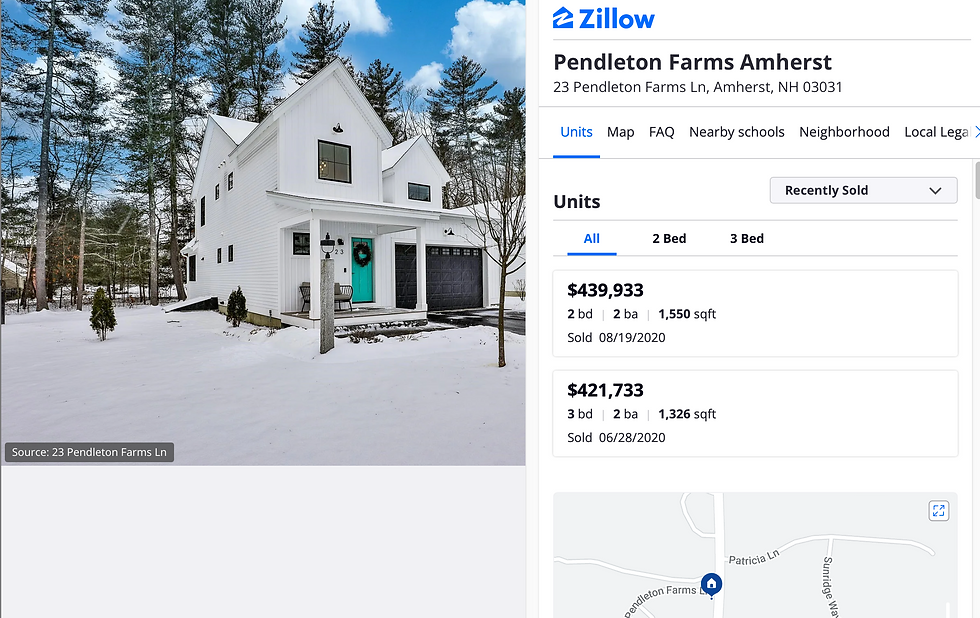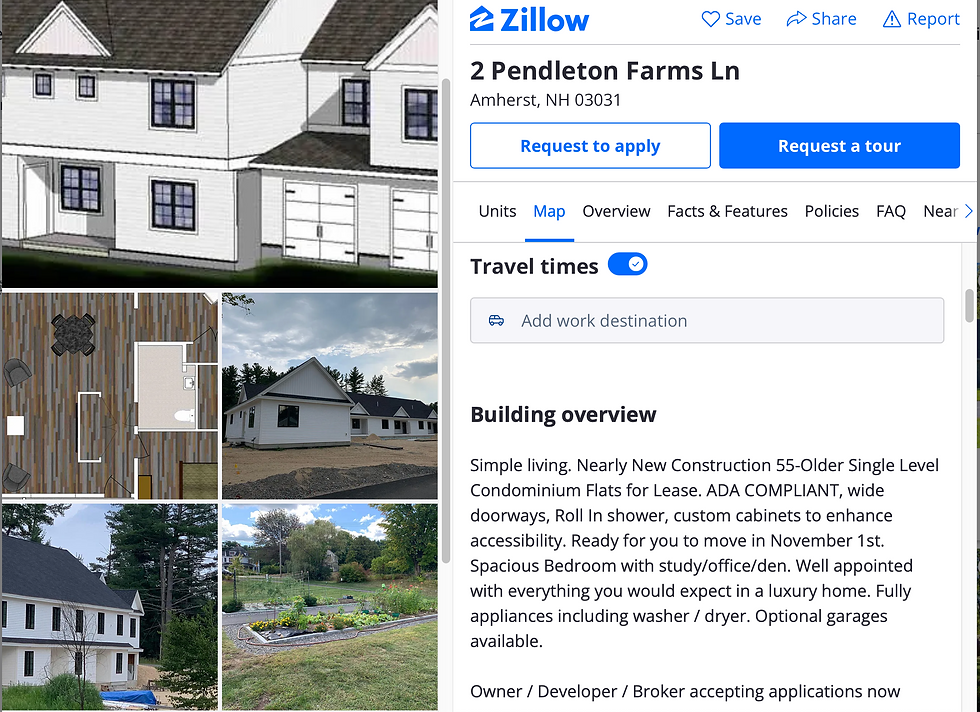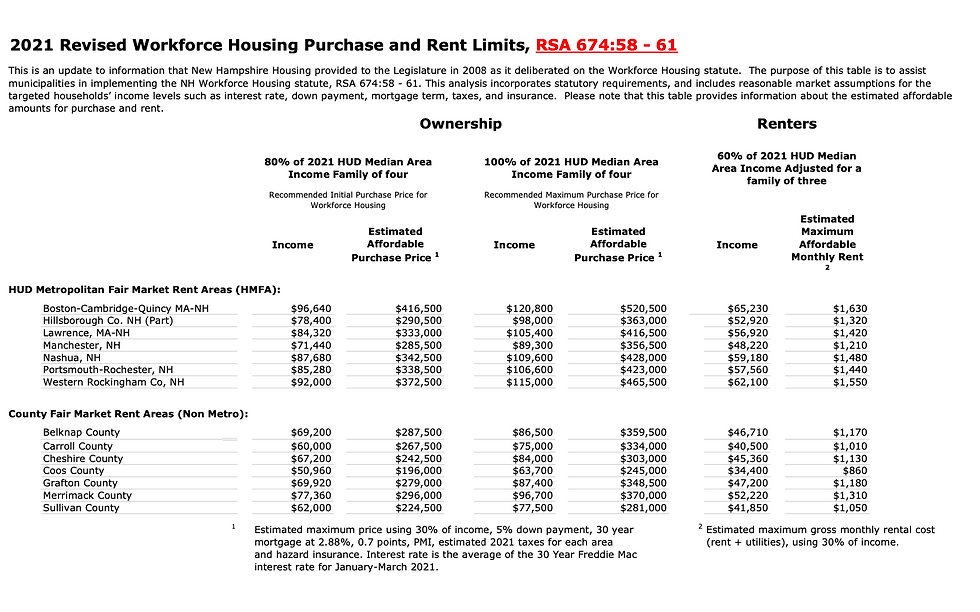Answering a Housing Affordability Question
- Admin

- Feb 25, 2023
- 5 min read
By Tim Kachmar
Some people are aghast at a comment I made that affordability does not belong in Amherst. Below I provide my justification for making that comment.
What qualifies as affordable based on how affordability is calculated by the state, the concept of affordability does not even make sense for a town like Amherst. So yes - I made that comment, but as usual it is being totally misunderstood because some are so blindly married to the IIHO (more on that below). In a recent post on the Amherst Resident’s Only Facebook page, Katie Holt Button (hi Sally W) asked me a series of questions regarding Pendleton Farms – the ideal “affordable” housing development created under the IIHO.
I’d like to address the “affordability” comment that Katie HB and all IIHO supporters keep repeating. Per her post, Katie is “struggling to identify what I find offensive in the development. Is it the 2 bedrooms and the type of affordable housing you don’t believe belongs in Amherst?” Clearly you and Sally and the other IIHO supporters have not even cracked Zillow to find out what the price of the these “affordable” units are going for.

Your ideal two-bedroom unit is going for $439,933 dollars, more than the 3 bedroom, although not by much. Is that Affordable to you? Even rental units are quite pricy at almost $2000 for a one-bedroom 55+ apartment. Oh, and those “open space” pictures look sweet. Lush!

Do you know the state of NH calculates affordability if 30 percent or less of the household’s income is spent on housing costs. “Workforce housing" is ownership housing that is affordable to a family of four earning up to 100 percent of the median income for the area, or rental housing that is affordable to a family of three earning up to 60 percent of the median income for the area. (Reference)
The median household income in Amherst, NH in 2019 was $140,019, which was 44.3% greater than the median annual income of $77,933 across the entire state of New Hampshire. Compared to the median income of $89,384 in 2000 this represents an increase of 36.2%. The per capita income in 2019 was $58,911, which means an increase of 39.7% compared to 2000 when it was $35,531. (Reference)

According to the 2020 NRPC report on Amherst, “Workforce housing” per NH RSA 674:58-61, means housing which is intended for sale, and which is affordable to a household with an income of no more than 100 percent of the median income for a 4-person household for the metropolitan area. “Workforce housing” also means rental housing which is affordable to a household with an income of no more than 60 percent of the median income for a 3-person household for the metropolitan area. For Amherst, this would be $336,500 for a house, and $1,390 for rent. We know that housing prices have risen significantly since then with the median house price in Amherst being $550,000 per Realtor.com. Right now, with interest rates, that is $4,132 per month for your mortgage, and $3,309 for the affordable house in Pendleton Farms, the two-bedroom, 1,550 square foot house (30 year fixed rate at ~7% interest). The down payments were $110,000 and $88,000, respectively.
The ideal IIHO Pendleton Farms providing "affordable" housing is way over the State's recommended limits per RS NH RSA 674:58-61 for both housing price and rent.

Using the baseline 28% of gross income to be spent on a mortgage (how a mortgage company generally calculates whether you are qualified, and also how the state calculates affordability because it is less than 30% of gross household income), one would roughly have to make around $144,000 per year to qualify for the “affordable” house in Pendleton Farms (plus have saved up for the down payment). For Amherst, this is considered by IIHO proponents “affordable” housing, it is just right at the median income range for Amherst which is 44% higher than the State average. So only those in Amherst at the median income or higher could afford our "affordable" housing and likely only those in higher income brackets from outside of Amherst. Pendleton Farms is affordable to the upper half of Amherst, but not to the rest of the State. So as long as we use median income to calculate the affordable home price, Amherst will be higher than most towns in NH. Oh, and show me a retired elderly couple that makes $144,000 per year. I have nothing against affordable housing in Amherst, but there will never be “affordable” housing in Amherst as long as we calculate it based on median income by town. So, by that method, the affordability concept does not work in Amherst.
And please find a property owner, builder or developer who just wants to build a few units and not make any money. With the cost of labor and materials, you’d be lucky to get anything built and sold below that median house value of $550,000. You really think a builder will build 20, two-bedroom units for $120,000 when they could get $430,000 or even $363,000 for them or build 10 units at $900,000.
Two things for the virtuous IIHO backers: 1) how about you work with our State Reps and Senator to make a bill to change the way affordability is calculated in NH, why don’t you propose it is based on Statewide or County median income? That will never get out of Committee as every real estate and construction lobbyist will pounce, that’s why it is calculated the way it is. 2) Come to the Jacobson Meeting on the 1st and ask the developer what he will be charging for the affordable housing there and what they will base their calculations on at the time the houses go up for sale. Ask him to put it in writing.
For Katie’s additional comments on Pendleton Farms, the whole bedroom calculation she based her argument on for Pendleton was based on the IIHO calculations. That was really a dumb way to calculate how many houses can be built. Its impractical and leads to over development by aggressive developers. Look at Clearview, they played the bedroom adjustment game, but would not commit to stop building if they hit the bedroom limit. Do you really think the number of bedrooms matters on how many people occupy a house? There are two people that live in a seven-bedroom house and then there are 10 people who live in a two-bedroom house. The number of bedrooms does not equal the number of residents. Ideology does not equal reality and the IIHO and all the ensuing cluster development ideas are just that, ideas that do not work when executed.
Basically, 23 acres of buildable land per current zoning equals 11 houses, but per the IIHO bedroom calculations and the Planning Board then that approved overdevelopment - we got 20 houses. Oh, and the lovely moniker “Condo Alley”.
How is that 69% open space being used since they clear cut almost every single tree up to the slopes – almost every single tree was cut down for lumber. That place looked like a war zone until the houses were built. Is that conservation? Is that green? Is that good for the climate? Is that good for native animals? And there was nothing that could be done with the PSNH powerline – that would have always remained and been a wildlife corridor regardless of how many houses got squeezed on the land.
So please spare me the virtuous indignation. I think it’s high time to stop pretending the IIHO was anything they sold it as. And for the love of God stop calling $440,000 “affordable”.


A home assessed at $336,500 would generate $5300 in school taxes, based on the current rate (21.13). This is less than 25% of the cost to educate one pupil in the Amherst school district ($22,300).